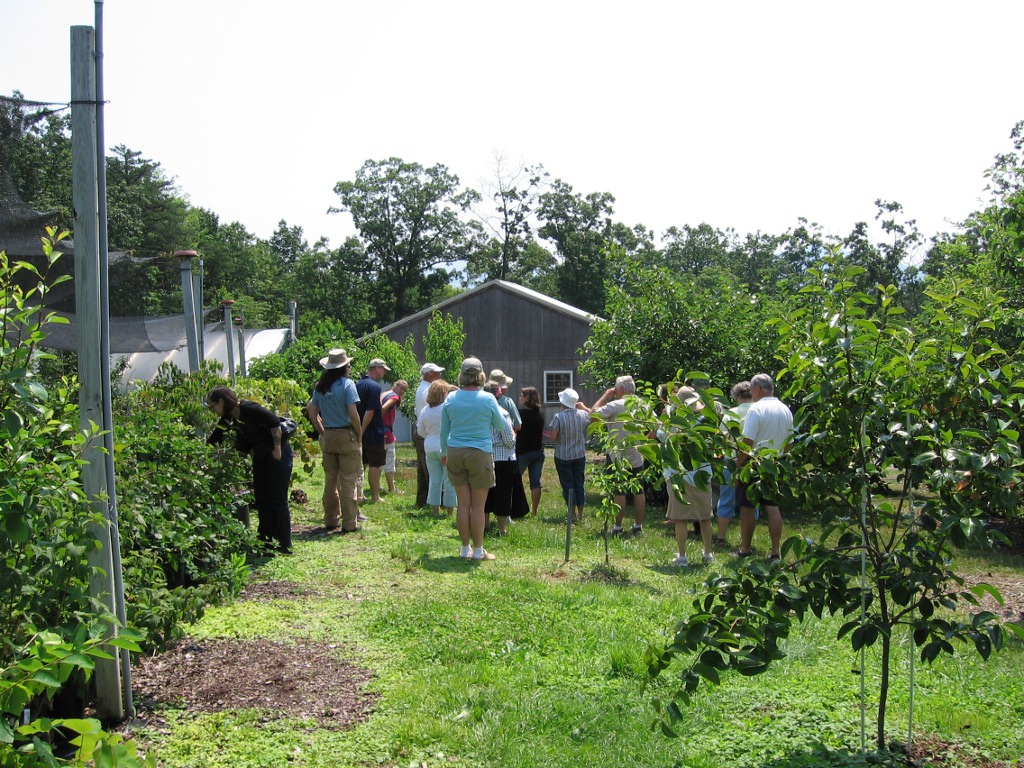Due to import restrictions we are unable to ship Cherries, Bush to CA,Europe...
| Nanking White Cherry Bush - Prunus tomentosa |
|---|
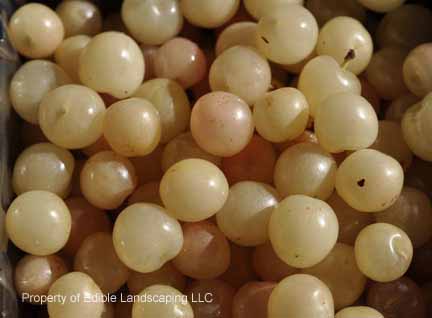 The sweetest of all the Nankings. A bush type cherry, very hardy with above average size fruit for the Nanking. Best in full sun as a foundation plant or as a fruitful hedge. Can also be grown in a container. Not always self fertile, to insure fruit set plant two. This is the best Nanking strain for eating fresh. We have three different stock plants of Nanking White cherries ie; #1, #2, and #3. If ordering more than one white fruiting Nanking, to insure cross pollination, choose any red Nanking or a different numbered white Nanking. For landscape effect Japanese plums bloom later but overlap with Nanking cherry. Height 4' - 8'. Space 6' circle. Zones 3-7.
The sweetest of all the Nankings. A bush type cherry, very hardy with above average size fruit for the Nanking. Best in full sun as a foundation plant or as a fruitful hedge. Can also be grown in a container. Not always self fertile, to insure fruit set plant two. This is the best Nanking strain for eating fresh. We have three different stock plants of Nanking White cherries ie; #1, #2, and #3. If ordering more than one white fruiting Nanking, to insure cross pollination, choose any red Nanking or a different numbered white Nanking. For landscape effect Japanese plums bloom later but overlap with Nanking cherry. Height 4' - 8'. Space 6' circle. Zones 3-7.
View detailed information
|
| Nanking Red Bush Cherry - Prunus tomentosa |
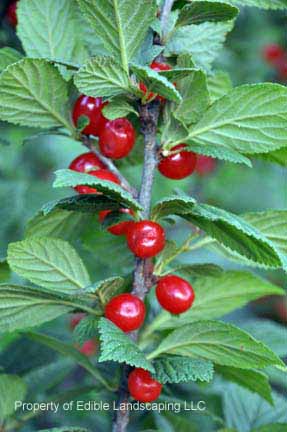 Same bush type characteristics of Nanking White. Ripe fruits are juicy, sub-acid to sweet, eaten raw or preserved. At the Edible Park in downtown Asheville NC, kids love them fresh from the bush. Not always self fertile, to insure fruit set, plant 2. Space 6 feet. For landscape effect Japanese plums blooms overlap Nanking cherry. Zones 3-7.
Same bush type characteristics of Nanking White. Ripe fruits are juicy, sub-acid to sweet, eaten raw or preserved. At the Edible Park in downtown Asheville NC, kids love them fresh from the bush. Not always self fertile, to insure fruit set, plant 2. Space 6 feet. For landscape effect Japanese plums blooms overlap Nanking cherry. Zones 3-7.
View detailed information
|
| Consort Black Currant - Ribes ussuriense |
|---|
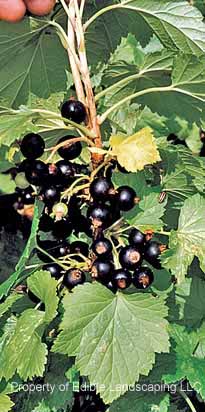 Consort is a productive rust resistant European black currant. It was bred and selected in Canada for immunity to White Pine Blister Rust.Clusters of medium size fruit mature in June on this small, compact bush 4-5' tall and wide. Consort likes rich sweet soil, but is widely adaptable and can thrive with neglect especially in the northeast US. Europeans love its assertive flavor and aroma and it is a benefit nutritionally for anyone that includes them in their diet, being high in vitamin C and omega fatty acids. Consort will grow and fruit in full shade and usually holds its leaves better in late summer in the shade in the warmer climate zones of its adaptability. It does not have showy flowers like American Black Currants nor is it the grape derived small raisin called currants in the health food stores. But they are cassis, commercially sold in soda, juice, wine, liquor or concentrate. Space 5' circle. Zones 4-7.
Consort is a productive rust resistant European black currant. It was bred and selected in Canada for immunity to White Pine Blister Rust.Clusters of medium size fruit mature in June on this small, compact bush 4-5' tall and wide. Consort likes rich sweet soil, but is widely adaptable and can thrive with neglect especially in the northeast US. Europeans love its assertive flavor and aroma and it is a benefit nutritionally for anyone that includes them in their diet, being high in vitamin C and omega fatty acids. Consort will grow and fruit in full shade and usually holds its leaves better in late summer in the shade in the warmer climate zones of its adaptability. It does not have showy flowers like American Black Currants nor is it the grape derived small raisin called currants in the health food stores. But they are cassis, commercially sold in soda, juice, wine, liquor or concentrate. Space 5' circle. Zones 4-7.
View detailed information
|
| Crandall American Black - Ribes odoratum |
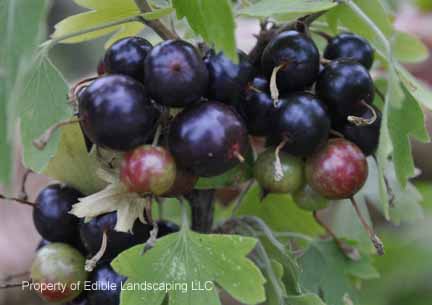 In the spring Crandall is a massive array of yellow trumpet shaped flowers. A most striking ornamental found in the best gardens in Europe. Swallowtail butterflies flock to the blooms. Also called Clove Currant and Missouri Currant. The unique taste of the shiny black fruit is pleasant. Height 4-5' Native, space 5' circle. Zones 4-7.
In the spring Crandall is a massive array of yellow trumpet shaped flowers. A most striking ornamental found in the best gardens in Europe. Swallowtail butterflies flock to the blooms. Also called Clove Currant and Missouri Currant. The unique taste of the shiny black fruit is pleasant. Height 4-5' Native, space 5' circle. Zones 4-7.
View detailed information Please contact our office to see about availability. 434.361.9134
|
| Cherry Red Currant - Ribes sativum |
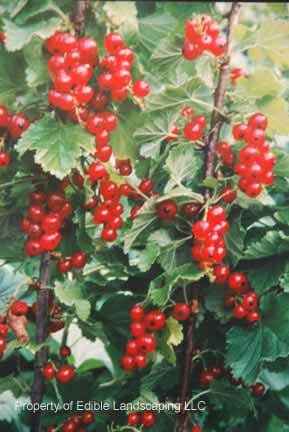 Cherry Red currant's fruit clusters are short and loose. The berries are very large, bright dark red, acidic and good. Plants are vigorous, upright and productive. Cherry Red resists mildew, a real plus in humid areas. A small bush in the landscape, Cherry Red is good in shade against buildings and with borders including strawberries or low growing herbs or flowers. Mixing with Josta or white and black currants 5' apart is fine since they are similar in size and habit. Space 5' circle Height 4-5' Zones 3-7.
Cherry Red currant's fruit clusters are short and loose. The berries are very large, bright dark red, acidic and good. Plants are vigorous, upright and productive. Cherry Red resists mildew, a real plus in humid areas. A small bush in the landscape, Cherry Red is good in shade against buildings and with borders including strawberries or low growing herbs or flowers. Mixing with Josta or white and black currants 5' apart is fine since they are similar in size and habit. Space 5' circle Height 4-5' Zones 3-7.
View detailed information Please contact our office to see about availability. 434.361.9134
|
| Primus White Currant - Ribes rubrum |
 Primus is a compact bush bearing long fruit clusters. Highly productive, up to 20 pounds of fruit per bush. As most currants it is self fertile. Fruit color is whiter than other white currants. Released from Slovakia in 1977 from a cross of Heinemann's Rote Spatlese X Red Lake. Zones 3-7 Space 5' circle Height 4-5'
Primus is a compact bush bearing long fruit clusters. Highly productive, up to 20 pounds of fruit per bush. As most currants it is self fertile. Fruit color is whiter than other white currants. Released from Slovakia in 1977 from a cross of Heinemann's Rote Spatlese X Red Lake. Zones 3-7 Space 5' circle Height 4-5'
View detailed information
|
| Red Lake Currant - Ribes Rubrum |
 Red Lake is a extremely ornamental mounding shrub 3'-5' tall and 3'-5' wide, with large clusters of flavorful bright red berries. Red Lake makes an excellent hedge! Red Lake is very cold hardy, mid afternoon shade is recommended for warmer summer climates. Plant in well drained fertile soil, dig in organic mulch for clay soils. Self fertile. Zone 3-7.
Red Lake is a extremely ornamental mounding shrub 3'-5' tall and 3'-5' wide, with large clusters of flavorful bright red berries. Red Lake makes an excellent hedge! Red Lake is very cold hardy, mid afternoon shade is recommended for warmer summer climates. Plant in well drained fertile soil, dig in organic mulch for clay soils. Self fertile. Zone 3-7.
View detailed information Sorry, we are currently out of this item, please check back!
|
| Cornelian Cherry Dogwood - Cornus mas |
|---|
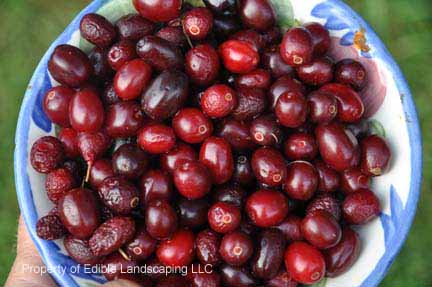 Cornelian Cherry has similar leaves and the same red fall color as the popular dogwood. It is a large, round bush up to 20' tall. Fruit is about 3/4" x 1/2" and plentiful on the tree, ripening in August. A few days after picking, fruits become soft and have a great, fresh taste, reminiscent of canned cranberry sauce. The yellow blossoms on naked gray branches rival witch hazel in beauty. Blooming in the late winter or very early in the springtime with daffodil. Needs a mate for fruit. Space 20 feet Zones 4-7.
Cornelian Cherry has similar leaves and the same red fall color as the popular dogwood. It is a large, round bush up to 20' tall. Fruit is about 3/4" x 1/2" and plentiful on the tree, ripening in August. A few days after picking, fruits become soft and have a great, fresh taste, reminiscent of canned cranberry sauce. The yellow blossoms on naked gray branches rival witch hazel in beauty. Blooming in the late winter or very early in the springtime with daffodil. Needs a mate for fruit. Space 20 feet Zones 4-7.
View detailed information
|
| Pioneer Cornelian Cherry - Cornus mas |
 Pioneer is a large fruiting Ukrainian variety call Lukyanovskii in Urkraine. A great easy care ornamental bush, producing pear shaped fruit in August. Height 10'-12' Space 10'15' circle Zone 3-8
Pioneer is a large fruiting Ukrainian variety call Lukyanovskii in Urkraine. A great easy care ornamental bush, producing pear shaped fruit in August. Height 10'-12' Space 10'15' circle Zone 3-8
View detailed information Please contact our office to see about availability. 434.361.9134
|
| Red Star Cornelian Cherry - Cornus mas |
 Red Star Cornelian Cherry was selected for its large tasty fruits. Called Vidubetskii in Ukraine, it is a fine pollinator for Pioneer. Height 10-12' Space 10-15' Zone 3-8
Red Star Cornelian Cherry was selected for its large tasty fruits. Called Vidubetskii in Ukraine, it is a fine pollinator for Pioneer. Height 10-12' Space 10-15' Zone 3-8
View detailed information
|
| Black Aronia - Aronia melanocarpa |
|---|
 Black Aronia is a small shrub about 6', with blueberry size black fruit that can be made into a healthy drink if sweetened.Blooms white flowers in spring followed by black fruits with vivid red leaves in the fall. Tolerates wet sites, sun or shade. Self fertile, not subject to any diseases or insect problems. Space 6' circle. Zones 3 - 8.
Black Aronia is a small shrub about 6', with blueberry size black fruit that can be made into a healthy drink if sweetened.Blooms white flowers in spring followed by black fruits with vivid red leaves in the fall. Tolerates wet sites, sun or shade. Self fertile, not subject to any diseases or insect problems. Space 6' circle. Zones 3 - 8.
View detailed information Please contact our office to see about availability. 434.361.9134
|
Due to import restrictions we are unable to ship Elaeagnus to CA...
| Sweet Scarlet Goumi - Eleagnus multiflora |
|---|
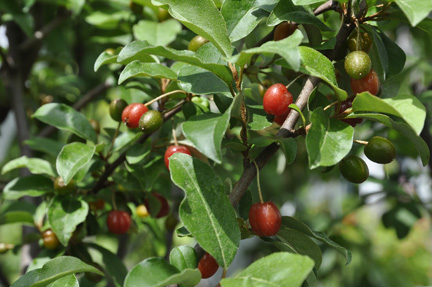 Sweet Scarlet Goumi is an attractive small shrub with olive shaped leaves and silvery under tones. The wood of the plant is a rich red brown, and the flowers are dainty and white. The fruits are clustered and dense with a deep red color. Fruits can be eaten fresh with other fruit or green salads, and juiced or made into jellies and jams. Their ease of care and dependable cropping make this plant a valued part of your collection. Not bothered by bugs or disease it can be a center piece in the yard. It is also a nitrogen fixing plant.Space 6' circle Zones 4-8
Sweet Scarlet Goumi is an attractive small shrub with olive shaped leaves and silvery under tones. The wood of the plant is a rich red brown, and the flowers are dainty and white. The fruits are clustered and dense with a deep red color. Fruits can be eaten fresh with other fruit or green salads, and juiced or made into jellies and jams. Their ease of care and dependable cropping make this plant a valued part of your collection. Not bothered by bugs or disease it can be a center piece in the yard. It is also a nitrogen fixing plant.Space 6' circle Zones 4-8
View detailed information Please contact our office to see about availability. 434.361.9134
|
| Adams Elderberry - Sambucus canadensis |
|---|
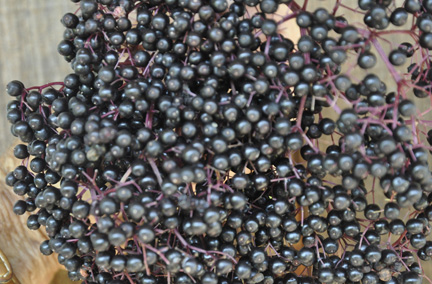 Adams is a native elderberry. Very juicy, purple berries, excellent for elixirs,pies, syrups,wine, etc. Late ripening and a heavy producer. Zones 3-9. Pollinates with other native elderberries. Very large flower heads. Height 6' to 12'. Space 10' circle Zone 3-9
Adams is a native elderberry. Very juicy, purple berries, excellent for elixirs,pies, syrups,wine, etc. Late ripening and a heavy producer. Zones 3-9. Pollinates with other native elderberries. Very large flower heads. Height 6' to 12'. Space 10' circle Zone 3-9
View detailed information Please contact our office to see about availability. 434.361.9134
|
| Johns Elderberry - Sambucus canadensis |
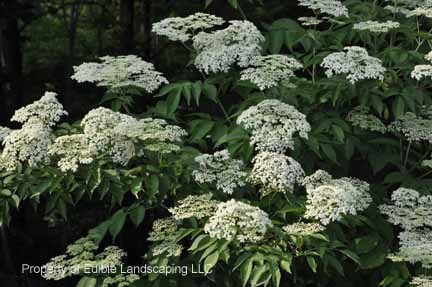 Johns produces more fruits and earlier than other varieties. Very large clusters of medium size berries. Especially good for jelly and elderberry elixir. Larger plant than Adams. Zones 3-9. Pollinate with Adams. Very large flower heads. Height 6' to 12'. Space 8' to 10' circle.
Johns produces more fruits and earlier than other varieties. Very large clusters of medium size berries. Especially good for jelly and elderberry elixir. Larger plant than Adams. Zones 3-9. Pollinate with Adams. Very large flower heads. Height 6' to 12'. Space 8' to 10' circle.
View detailed information Please contact our office to see about availability. 434.361.9134
|
| Nova Elderberry - Sambucus canadensis |
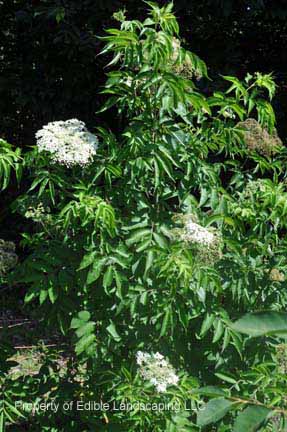 Nova was selected and introduced from Vineland Fruit Station, Ontario, Canada. Fruit clusters are above average and plant will set fruit planted alone. Does best in colder zones. Zones 3- 6. Smaller bush than Adams. Space 6' circle
Nova was selected and introduced from Vineland Fruit Station, Ontario, Canada. Fruit clusters are above average and plant will set fruit planted alone. Does best in colder zones. Zones 3- 6. Smaller bush than Adams. Space 6' circle
View detailed information
|
| Cut Leaf Elderberry - Sambucus nigra laciniata |
 A most beautiful form of European elderberry. A 6-8' shrub with deep cut lobed leaves followed by large heads of creamy white flowers and shiny berries. Pollinate with Black Lace, though we think it's self fertile. Space 6' to 8' circle Zones 3-9.
A most beautiful form of European elderberry. A 6-8' shrub with deep cut lobed leaves followed by large heads of creamy white flowers and shiny berries. Pollinate with Black Lace, though we think it's self fertile. Space 6' to 8' circle Zones 3-9.
View detailed information
|
| Black Lace Elderberry - Sambucus nigra |
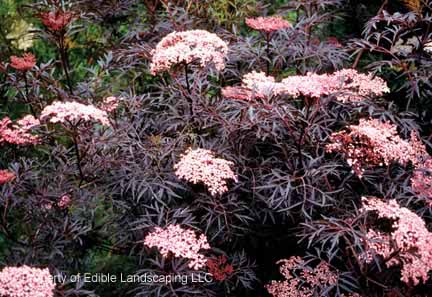 Dark purple-black leaves and pink flower clusters. Foliage stays dark throughout the growing season. Very ornamental.Resists leaf diseases. A European elderberry that fruits best with another European sort like Cut Leaf. Height 8'. Space 6' to 8' circle Zone 4-9.
Dark purple-black leaves and pink flower clusters. Foliage stays dark throughout the growing season. Very ornamental.Resists leaf diseases. A European elderberry that fruits best with another European sort like Cut Leaf. Height 8'. Space 6' to 8' circle Zone 4-9.
View detailed information Sorry, we are currently out of this item, please check back!
|
| Bob Gordon Elderberry - Sambucus canadensis |
|
View detailed information Please contact our office to see about availability. 434.361.9134
|
Due to import restrictions we are unable to ship Figs to Europe...
| Hardy Chicago Fig - Ficus carica |
|---|
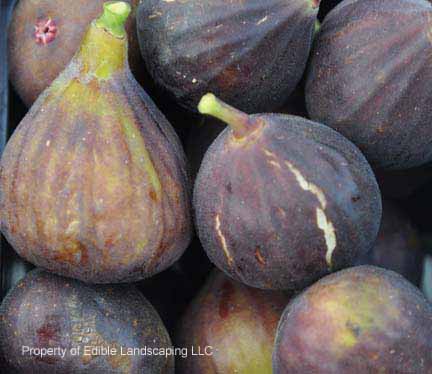 A brown fig, rich and sweet. Good for potted culture, although it is our most dependable outdoor fig. Hardy Chicago ripens its figs from August until fall frost and will have some fruit in July. Has produced as many as 100 pints of figs in one season. Does extremely well in NC and we send this one to enthusiasts up north, because of its early fruiting tendency. Success will vary with every location, so be sure to give it the warmest, most protected place. It's our best fig and came to our attention in the 1970's when cuttings for propagation came from Fred Borne, a North American Fruit Explorer member. Cuttings were supplied to him from a man from Chicago with a "U" shaped house, from a bush he had protected for some years. Without protection the mature bushes top would die back from winter cold, but sprouted from the roots and ripened some figs at the end of the season. Most fig varieties do not share this trait. Usually, a fig's above ground growth must survive the winter in order to fruit the following season. Leaves are the 5-lobed type and the plant has a bush form in the east. Space 8' to 10' circle in Zone 7. Zones 6-8.
A brown fig, rich and sweet. Good for potted culture, although it is our most dependable outdoor fig. Hardy Chicago ripens its figs from August until fall frost and will have some fruit in July. Has produced as many as 100 pints of figs in one season. Does extremely well in NC and we send this one to enthusiasts up north, because of its early fruiting tendency. Success will vary with every location, so be sure to give it the warmest, most protected place. It's our best fig and came to our attention in the 1970's when cuttings for propagation came from Fred Borne, a North American Fruit Explorer member. Cuttings were supplied to him from a man from Chicago with a "U" shaped house, from a bush he had protected for some years. Without protection the mature bushes top would die back from winter cold, but sprouted from the roots and ripened some figs at the end of the season. Most fig varieties do not share this trait. Usually, a fig's above ground growth must survive the winter in order to fruit the following season. Leaves are the 5-lobed type and the plant has a bush form in the east. Space 8' to 10' circle in Zone 7. Zones 6-8.
View detailed information
|
| Celeste Fig - Ficus carica |
 Celeste is also known in the South as the "Sugar Fig". A Southern tradition, long-lived and hardy, Celeste's reputation comes from many generations of people that have grown this fig. The "eye" at the bottom of the fruit is small, keeping insects out. Fruits main crop early on last years wood. Good for pots. Space 10' circle in Zone 7 and 12' circle in the South. Zones 6-9.
Celeste is also known in the South as the "Sugar Fig". A Southern tradition, long-lived and hardy, Celeste's reputation comes from many generations of people that have grown this fig. The "eye" at the bottom of the fruit is small, keeping insects out. Fruits main crop early on last years wood. Good for pots. Space 10' circle in Zone 7 and 12' circle in the South. Zones 6-9.
View detailed information
|
| Brown Turkey Fig - Ficus carica |
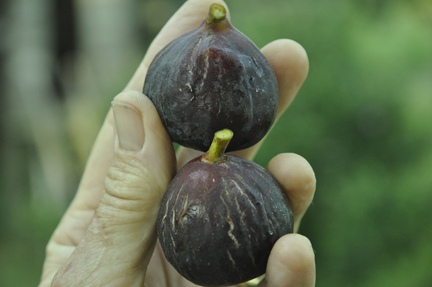 Brown Turkey fig does well in large pots and fruits well in Northern areas such as Long Island, NY. Very good against walls in Northern areas. Brown fruit with amber flesh. Space 8' to 10' circle Zones 6-9.
Brown Turkey fig does well in large pots and fruits well in Northern areas such as Long Island, NY. Very good against walls in Northern areas. Brown fruit with amber flesh. Space 8' to 10' circle Zones 6-9.
View detailed information
|
| LSU Purple Fig - Ficus carica |
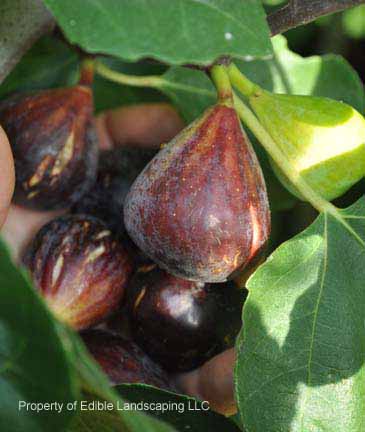 LSU Purple fig is a very reliable, prolific producer of early to late delicious figs. One of the best figs to come along for some time. Excellent for containers, producing early figs as soon as growth starts. Very acclimated to the fluctuating weather of the South, does great in Virginia Beach. Zones 7-9. Has fruited well at our nursery (zone 7). A customer from Hamilton Square, NJ (zone 6) is fruiting LSU Purple successfully outside. More nematode resistant than most figs in Florida. Best to pick a few days after fruit turns black, wrinkles and elongates. Space 10' to 12' circle
LSU Purple fig is a very reliable, prolific producer of early to late delicious figs. One of the best figs to come along for some time. Excellent for containers, producing early figs as soon as growth starts. Very acclimated to the fluctuating weather of the South, does great in Virginia Beach. Zones 7-9. Has fruited well at our nursery (zone 7). A customer from Hamilton Square, NJ (zone 6) is fruiting LSU Purple successfully outside. More nematode resistant than most figs in Florida. Best to pick a few days after fruit turns black, wrinkles and elongates. Space 10' to 12' circle
View detailed information
|
| Conadria Fig - Ficus carica |
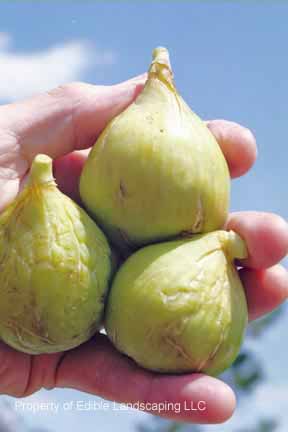 Conadria is our largest yellow fig with high sugar content. Some can set snugly in a tea cup. Can be used for dried figs and fresh fruit. Introduced in 1955 by Ira Condit USDA Riverside, CA. Fruit resists spoilage in rainy weather and has a small eye so it rates good for insect resistance. Produces 2 crops. The 1st crop, breba crop is good, the second crop, very good. In zone 7 produces only one crop. Can be grown in a 10 gallon pot and planted in the ground, in the pot, after winter storage (temps no lower than 30 degrees F) where it will root through the pot and produce large excellent figs in summer, as experience by a hobbyist in Smyrna, Delaware. Plant is vigorous, precocious, widely planted in the San Joaquin Valley, CA. Zone 5-7 pots. Space 10' circle in Virginia and 15' circle Zone 8 & 9. Conadria has also been called Galbun mistakenly. Zone 7-9
Conadria is our largest yellow fig with high sugar content. Some can set snugly in a tea cup. Can be used for dried figs and fresh fruit. Introduced in 1955 by Ira Condit USDA Riverside, CA. Fruit resists spoilage in rainy weather and has a small eye so it rates good for insect resistance. Produces 2 crops. The 1st crop, breba crop is good, the second crop, very good. In zone 7 produces only one crop. Can be grown in a 10 gallon pot and planted in the ground, in the pot, after winter storage (temps no lower than 30 degrees F) where it will root through the pot and produce large excellent figs in summer, as experience by a hobbyist in Smyrna, Delaware. Plant is vigorous, precocious, widely planted in the San Joaquin Valley, CA. Zone 5-7 pots. Space 10' circle in Virginia and 15' circle Zone 8 & 9. Conadria has also been called Galbun mistakenly. Zone 7-9
View detailed information
|
| Violet de Bordeaux Fig - Ficus carica |
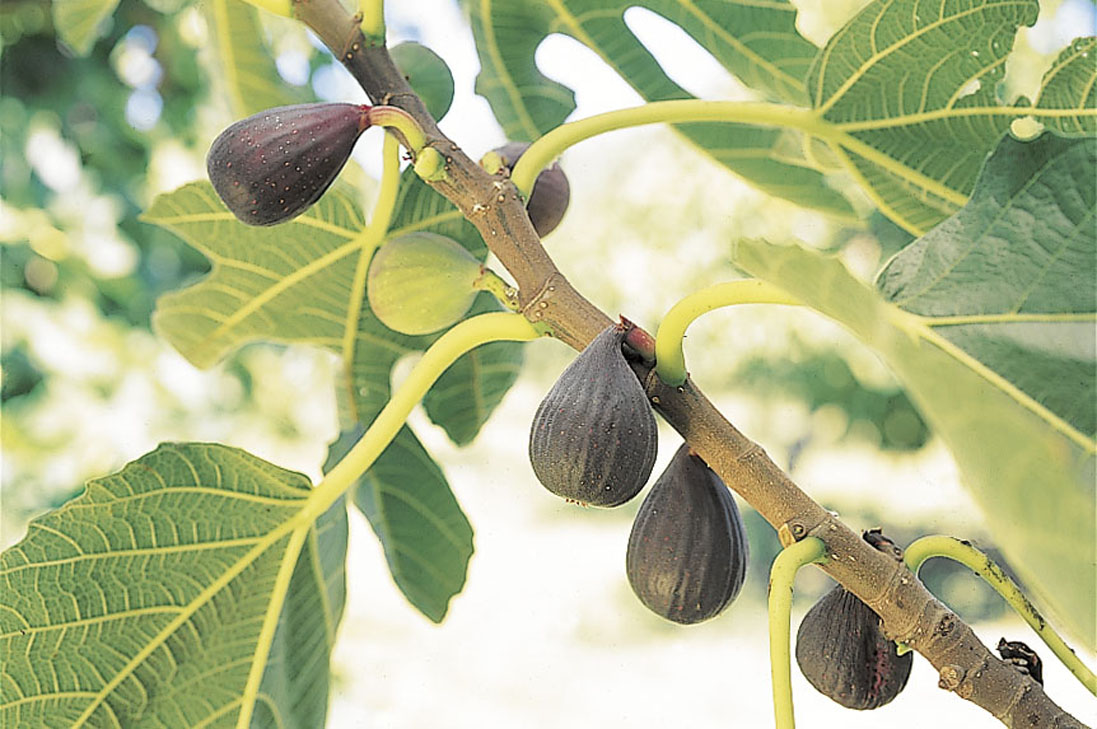 Also known as Negronne, Violet de Bordeaux is a purplish-black fruit with rich strawberry pulp. Considered by many the finest tasting fig. Popular in the Northwest and West. Needs protection in cold winter areas. Good for home planting as tree is dwarf. Similar fruit to Black Mission, but hardier and a smaller size tree than Mission. Fruit ripens later than Hardy Chicago, Marseilles and Celeste. Closed eye. Space 8' circle. Zones 7b-9.
Also known as Negronne, Violet de Bordeaux is a purplish-black fruit with rich strawberry pulp. Considered by many the finest tasting fig. Popular in the Northwest and West. Needs protection in cold winter areas. Good for home planting as tree is dwarf. Similar fruit to Black Mission, but hardier and a smaller size tree than Mission. Fruit ripens later than Hardy Chicago, Marseilles and Celeste. Closed eye. Space 8' circle. Zones 7b-9.
View detailed information Please contact our office to see about availability. 434.361.9134
|
| Petite Negri - Ficus carica |
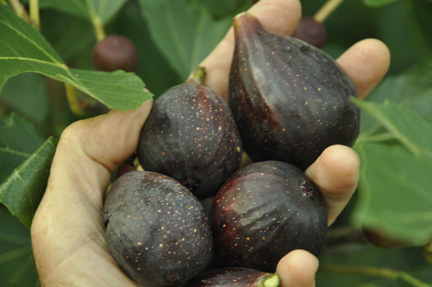 Petite Negri is a large black fig with excellent flavor. One of the best producers for pot culture. The dwarf plant is very productive. Similar to Black Mission and Violet de Bordeaux fig and produces an early and late crop when potted. Outside culture is for zones 7-9. Produces one crop outside at our nursery. Space 8' circle.
Petite Negri is a large black fig with excellent flavor. One of the best producers for pot culture. The dwarf plant is very productive. Similar to Black Mission and Violet de Bordeaux fig and produces an early and late crop when potted. Outside culture is for zones 7-9. Produces one crop outside at our nursery. Space 8' circle.
View detailed information Please contact our office to see about availability. 434.361.9134
|
| Texas BA-1 Fig - Ficus carica |
 Sweetest of our collection. Hardy in 7 if protected from the wind.Space 10' circle. Ripens 2 weeks later than Hardy Chicago. Zone 7-8
Sweetest of our collection. Hardy in 7 if protected from the wind.Space 10' circle. Ripens 2 weeks later than Hardy Chicago. Zone 7-8
View detailed information Please contact our office to see about availability. 434.361.9134
|
| Osborne Fig - Ficus carica |
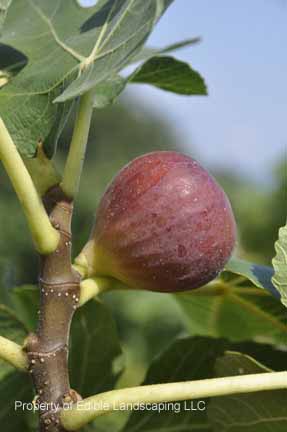 This fig has fruited for us at the nursery about one week after the St. Anthony Marseilles. It differs from most of our varieties with its reddish skin color and amber flesh. I enjoy this fig fresh in summer and fresh frozen in the winter. Space 8' circle. Zone 7-9.
This fig has fruited for us at the nursery about one week after the St. Anthony Marseilles. It differs from most of our varieties with its reddish skin color and amber flesh. I enjoy this fig fresh in summer and fresh frozen in the winter. Space 8' circle. Zone 7-9.
View detailed information
|
| Lattarulla Fig - Ficus carica |
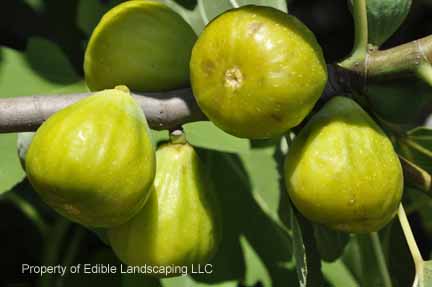 At our nursery Lattarulla ripens its yellow figs earlier then all others, usually starting in June or July. Because of fluctuating winter weather, these buds can become damaged and not fruit as much as in milder regions such as the Pacific Northwest. The fall crops are inferior fruit because they need pollination from a fig wasp that only lives in Europe in fig producing countries or parts of California. King fig seems to be the same as Lattarulla. Also called Danny's Delight, this fig has ripened its fruit near Lake Michigan outside. Figs are large, pale green to yellow, sweet and delicious. Fruits are well worth the effort since they are the first to ripen, usually in mid-June at our nursery. Success will vary in zones 6-8. Space 10' circles
At our nursery Lattarulla ripens its yellow figs earlier then all others, usually starting in June or July. Because of fluctuating winter weather, these buds can become damaged and not fruit as much as in milder regions such as the Pacific Northwest. The fall crops are inferior fruit because they need pollination from a fig wasp that only lives in Europe in fig producing countries or parts of California. King fig seems to be the same as Lattarulla. Also called Danny's Delight, this fig has ripened its fruit near Lake Michigan outside. Figs are large, pale green to yellow, sweet and delicious. Fruits are well worth the effort since they are the first to ripen, usually in mid-June at our nursery. Success will vary in zones 6-8. Space 10' circles
View detailed information
|
| Verte (Green Ischia) - Ficus carica |
 Verte ripens about the same time as LSU Purple, so best to grow in zone 7 - 8. In a long season fruits will dry on the tree around October. Very sweet and good for drying. Since they ripen with their outside color green, they will fool the birds. The dark red flesh is in total contrast to the green skin. Strawberry is used to describe the inside color of the fruit. Also called Green Ischia. In our area plants are bush like and of small stature like Violet de Bordeaux.Fruit flavor is excellent. Space about 8' - 10' circle in Zone 6 - 7 and space 12'-15' circle in Zone 8.
Verte ripens about the same time as LSU Purple, so best to grow in zone 7 - 8. In a long season fruits will dry on the tree around October. Very sweet and good for drying. Since they ripen with their outside color green, they will fool the birds. The dark red flesh is in total contrast to the green skin. Strawberry is used to describe the inside color of the fruit. Also called Green Ischia. In our area plants are bush like and of small stature like Violet de Bordeaux.Fruit flavor is excellent. Space about 8' - 10' circle in Zone 6 - 7 and space 12'-15' circle in Zone 8.Verte ripens on second year wood. Winter protection is cooler areas is a must if you want fruit that year. View detailed information
|
| Kadota Fig - Ficus carica |
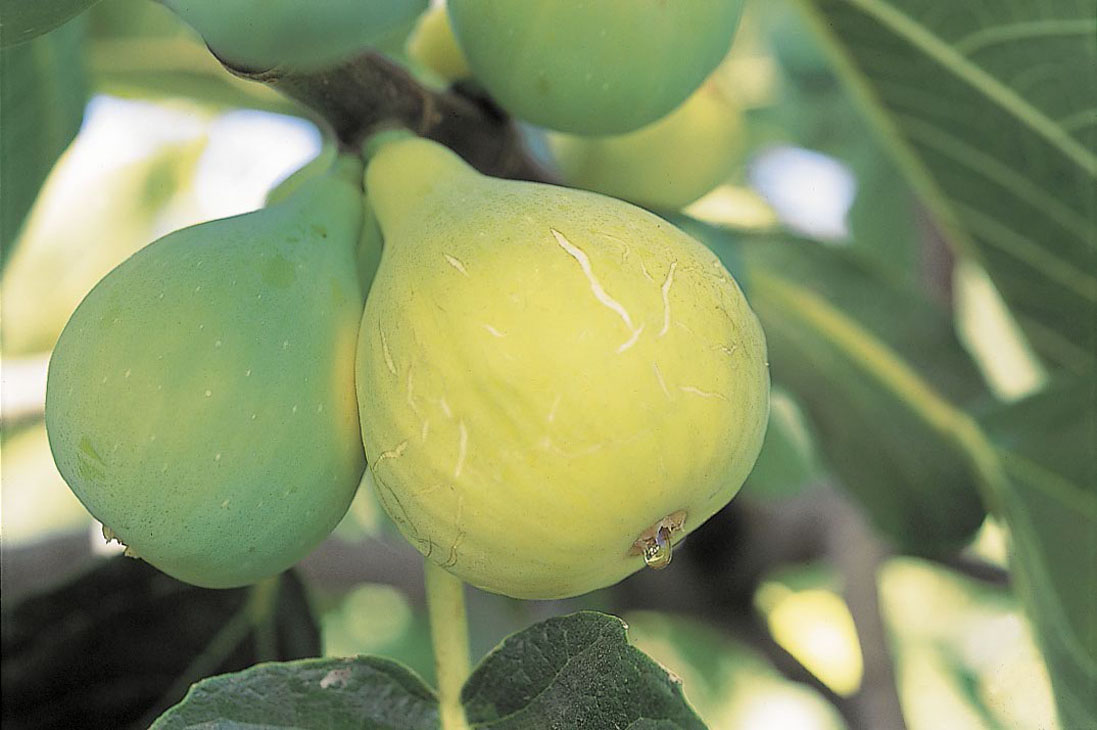 In zone 7, Kadota is an open bush, ripening most of its figs on last years growth. The fruits are yellow, medium to large size and delicious, ripening best with full sun and hot temperatures. Also known as Peter's Honey fig. Kadota is a popular fig because as a canned product it can be purchased in super markets in the US. Kadota is excellent fresh and very sweet. It sometimes ripens a few early figs that are extremely large. Space 10' circle
In zone 7, Kadota is an open bush, ripening most of its figs on last years growth. The fruits are yellow, medium to large size and delicious, ripening best with full sun and hot temperatures. Also known as Peter's Honey fig. Kadota is a popular fig because as a canned product it can be purchased in super markets in the US. Kadota is excellent fresh and very sweet. It sometimes ripens a few early figs that are extremely large. Space 10' circle
View detailed information Please contact our office to see about availability. 434.361.9134
|
| Panache Fig - Ficus carica |
 Extremely flavorful fig similar in taste and interior color to Verte, but its surface is striped yellow and green. Zone 8 - 10. Zone 7 with protection.
Extremely flavorful fig similar in taste and interior color to Verte, but its surface is striped yellow and green. Zone 8 - 10. Zone 7 with protection.
View detailed information
|
| Marseilles Fig - Ficus carica |
 Large yellow figs ripen the end of July on previous seasons growth. Very productive and early ripening. Produces an early main crop of short neck delicately sweet fruit. The plant slows it's growth into the fall and "hardens off" well. There is usually no young wood die back the following spring. Usually starts ripening a few weeks before Hardy Chicago and ends its production before Hardy Chicago does. Space 8'-10' circle, Zone 6 - 9. Also called Oregon Prolific and St. Anthony Fig.
Large yellow figs ripen the end of July on previous seasons growth. Very productive and early ripening. Produces an early main crop of short neck delicately sweet fruit. The plant slows it's growth into the fall and "hardens off" well. There is usually no young wood die back the following spring. Usually starts ripening a few weeks before Hardy Chicago and ends its production before Hardy Chicago does. Space 8'-10' circle, Zone 6 - 9. Also called Oregon Prolific and St. Anthony Fig.
View detailed information
|
| O'Rourke Fig - Ficus carica |
 O'Rourke flesh is golden with red near center of the fruit when soft ripe. Ripens before Celeste. Fruit hangs down when fully ripe. O'Rourke is more resistant to defoliation caused by fig leaf rust. Ripens its fruits early and continues late into the fall. A new variety from LSU with Celeste in its parentage. Zones 6-9 Space 10' circle
O'Rourke flesh is golden with red near center of the fruit when soft ripe. Ripens before Celeste. Fruit hangs down when fully ripe. O'Rourke is more resistant to defoliation caused by fig leaf rust. Ripens its fruits early and continues late into the fall. A new variety from LSU with Celeste in its parentage. Zones 6-9 Space 10' circle
View detailed information
|
| Olympian Fig - Ficus carica |
 Olympian fig won the Retailers Choice Award at the 2014 FarWest Show. Olympian is a cold hardy fig and absolutely delicious. This fig produces very sweet fruits with thin purple skin with a red to violet flesh. Discovered by retired biologist Denny McGaughy, he named it after the city where he found it in a sheltered location. Denny worked with Malli Aradhy, a geneticist with the U.S. Department of Agriculture's National Clonal Germplasm Repository to conduct DNA test to find out if it was a known cultivar. It did not match any of the 200+ figs in the repository. It appears Denny has found a unique heirloom variety that produces well in cool & coastal climates. Zone 7-9 May work in Zone 6 with warmer micro climate. Space 10' circle
Olympian fig won the Retailers Choice Award at the 2014 FarWest Show. Olympian is a cold hardy fig and absolutely delicious. This fig produces very sweet fruits with thin purple skin with a red to violet flesh. Discovered by retired biologist Denny McGaughy, he named it after the city where he found it in a sheltered location. Denny worked with Malli Aradhy, a geneticist with the U.S. Department of Agriculture's National Clonal Germplasm Repository to conduct DNA test to find out if it was a known cultivar. It did not match any of the 200+ figs in the repository. It appears Denny has found a unique heirloom variety that produces well in cool & coastal climates. Zone 7-9 May work in Zone 6 with warmer micro climate. Space 10' circle
View detailed information
|
| GE Neri Fig - Ficus carica |
|
GE Neri can be tennis ball size. An Italian fig regarded as very sweet.We are getting to know this variety and will add more about it as we grow it. Probably Zones 8-9 Space 10' circle
View detailed information
|
Due to import restrictions we are unable to ship Flowers to PR,...
| Purple Pavement Rose Hip Rose - Rosa rugusa |
|---|
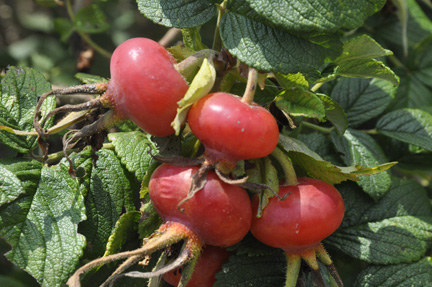 Purple Pavement Rose is also known as Rotsmere in Germany. It is a carefree dwarf rose. Healthy repeat blooms start a week later than Foxy Pavement and is very fragrant. Height 3' and same width. Purple Pavement will spread to a 6' circle. The very hardy shrub has huge red hips in late summer and fall. Leaves do not get leaf spot. Zones 3-8
Purple Pavement Rose is also known as Rotsmere in Germany. It is a carefree dwarf rose. Healthy repeat blooms start a week later than Foxy Pavement and is very fragrant. Height 3' and same width. Purple Pavement will spread to a 6' circle. The very hardy shrub has huge red hips in late summer and fall. Leaves do not get leaf spot. Zones 3-8
View detailed information Please contact our office to see about availability. 434.361.9134
|
| Snow Pavement Rose Hip Rose - Rosa rugusa |
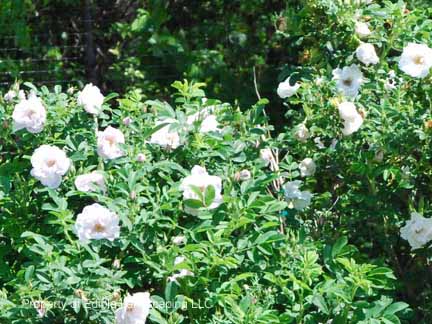 Snow pavement is also known as Schneekoppe. Flowers are white tinged with lavender pink, very fragrant, semi-double petals blooming throughout the growing season. Light red rose hips in summer and fall on this compact spreading bush. Leaves do not get leaf spot. Space 5' circle. Zones 3 - 8.
Snow pavement is also known as Schneekoppe. Flowers are white tinged with lavender pink, very fragrant, semi-double petals blooming throughout the growing season. Light red rose hips in summer and fall on this compact spreading bush. Leaves do not get leaf spot. Space 5' circle. Zones 3 - 8.
View detailed information
|
| Foxy Pavement Rose Hip Rose - Rosa rugusa |
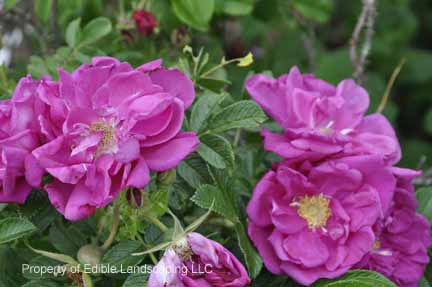 Foxy Pavement rose is a double pink, black spot immune, care free, three foot tall and wide dwarf rose bush. The deep pink variety is an improvement over Frau Dagmar Hastrup which it resembles. Good for tough conditions and very hardy, the heavenly fragrant flowers give way to large rose hips up to 1" in diameter, turning dark red in the fall. Space 3' to 5' circle Zones 3 - 8.
Foxy Pavement rose is a double pink, black spot immune, care free, three foot tall and wide dwarf rose bush. The deep pink variety is an improvement over Frau Dagmar Hastrup which it resembles. Good for tough conditions and very hardy, the heavenly fragrant flowers give way to large rose hips up to 1" in diameter, turning dark red in the fall. Space 3' to 5' circle Zones 3 - 8.
View detailed information Please contact our office to see about availability. 434.361.9134
|
| Light Pink Dwarf Pavement - Rosa Rugosa Hybrid |
|
View detailed information
|
| Phoenix Tears Goji Berry - Lycium barbarum |
|---|
 The rave of the health food industry, this Goji hails from China. A vining shrub up to 3'-6' tall. Fruits ripen throughout summer. Best to prune to a bush form. Hardy to -10 degrees F. Plant in full to partial sun with good soil drainage. Some extra lime to keep the pH up to 7 keeps Goji plants happy. Our self fertile variety is a seedling selected in Phoenix, AZ. The seeds originated from plants grown in Ningxia Provence, China, a main exporter of dried Goji berries. We've found that the berry sweetens for fresh eating in the late stages of ripeness, like tiny water balloons ready to drop at the slightest touch. Space 6' circle on trellis Zone 5-9
The rave of the health food industry, this Goji hails from China. A vining shrub up to 3'-6' tall. Fruits ripen throughout summer. Best to prune to a bush form. Hardy to -10 degrees F. Plant in full to partial sun with good soil drainage. Some extra lime to keep the pH up to 7 keeps Goji plants happy. Our self fertile variety is a seedling selected in Phoenix, AZ. The seeds originated from plants grown in Ningxia Provence, China, a main exporter of dried Goji berries. We've found that the berry sweetens for fresh eating in the late stages of ripeness, like tiny water balloons ready to drop at the slightest touch. Space 6' circle on trellis Zone 5-9
View detailed information
|
| Berry Blue Edible Honeysuckle (Haskap) - Lonicera kamtschatica |
|---|
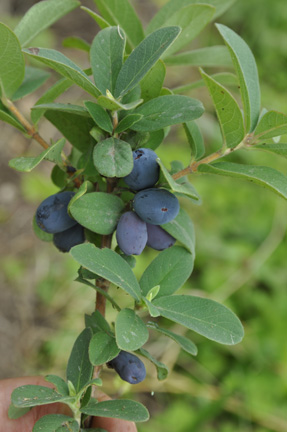 Berry Blue is our pollinator for Indigo Gem, Indigo Treat, and Tundra. A one to five ratio is fine as long as Berry Blue is included.Berry Blue is a Russian selection also called Czech 17 (P-17). It has an extended flowering period up to 8 weeks. If ordering only 2 varieties make sure one is Berryblue. These compact, small pretty European bushes are our first fruits to ripen at the nursery. Very hardy, they thrive in Siberia. The flowers are not showy or scented like a honeysuckle vine but the fruits are good. Blue, tart and flavorful, the fruits ripen before strawberries. Can be shy producers in areas prone to late frosts. Also known as Honeyberry and Haskap, Berryblue edible honeysuckle is a easy care addition to any landscape. They perform best in colder zones 5,4,and3. Zone 3-7. Space 4' circle
Berry Blue is our pollinator for Indigo Gem, Indigo Treat, and Tundra. A one to five ratio is fine as long as Berry Blue is included.Berry Blue is a Russian selection also called Czech 17 (P-17). It has an extended flowering period up to 8 weeks. If ordering only 2 varieties make sure one is Berryblue. These compact, small pretty European bushes are our first fruits to ripen at the nursery. Very hardy, they thrive in Siberia. The flowers are not showy or scented like a honeysuckle vine but the fruits are good. Blue, tart and flavorful, the fruits ripen before strawberries. Can be shy producers in areas prone to late frosts. Also known as Honeyberry and Haskap, Berryblue edible honeysuckle is a easy care addition to any landscape. They perform best in colder zones 5,4,and3. Zone 3-7. Space 4' circle
View detailed information
|
| Indigo Gem Haskap Honeysuckle - Lonicera Caerulea |
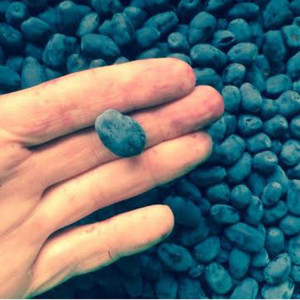 These compact, small pretty European bushes are our first fruits to ripen at the nursery. Very hardy, they thrive in Siberia. The flowers are not showy or scented like a honeysuckle vine but the fruits are good. Blue, tart and flavorful, the fruits ripen before strawberries. Can be shy producers in areas prone to late frosts. Also known as Honeyberry, Ingigo Gem edible honeysuckle is a easy care addition to any landscape. They perform best in colder zones 5,4,and 3. Zone 3-7. Space 4' circle Indigo Gem's fruit is medium size with a sweet tangy flavor. Indigo Gem is a productive cultivar that is good for processing or fresh. Flowers profusely for about 6 weeks. indigo Gem needs Berry Blue to pollinate it. Zones 3-7 Space 4' circle
These compact, small pretty European bushes are our first fruits to ripen at the nursery. Very hardy, they thrive in Siberia. The flowers are not showy or scented like a honeysuckle vine but the fruits are good. Blue, tart and flavorful, the fruits ripen before strawberries. Can be shy producers in areas prone to late frosts. Also known as Honeyberry, Ingigo Gem edible honeysuckle is a easy care addition to any landscape. They perform best in colder zones 5,4,and 3. Zone 3-7. Space 4' circle Indigo Gem's fruit is medium size with a sweet tangy flavor. Indigo Gem is a productive cultivar that is good for processing or fresh. Flowers profusely for about 6 weeks. indigo Gem needs Berry Blue to pollinate it. Zones 3-7 Space 4' circleView detailed information
|
| Indigo Treat Haskap Honeysuckle - Lonicera kamtschatica |
 These compact, small pretty European bushes are our first fruits to ripen at the nursery. Very hardy, they thrive in Siberia. The flowers are not showy or scented like a honeysuckle vine but the fruits are good. Blue, tart and flavorful, the fruits ripen before strawberries. Can be shy producers in areas prone to late frosts. Also known as Honeyberry, Indigo Treat edible honeysuckle is a easy care addition to any landscape. They perform best in colder zones 5,4,and 3. Introduced from the University of Saskatchewan, Indigo Treat fruits are high in flavor and sweeter than most. The light blue fruits are longer and flatter than other cultivars, are attractive and have a sweet plum flavor. The plants have medium to high vigor growing to 5.5 feet tall, with average to high yields. Indigo Treat needs Berry Blue to set fruit. Zone 3-7. Space 4' circle
These compact, small pretty European bushes are our first fruits to ripen at the nursery. Very hardy, they thrive in Siberia. The flowers are not showy or scented like a honeysuckle vine but the fruits are good. Blue, tart and flavorful, the fruits ripen before strawberries. Can be shy producers in areas prone to late frosts. Also known as Honeyberry, Indigo Treat edible honeysuckle is a easy care addition to any landscape. They perform best in colder zones 5,4,and 3. Introduced from the University of Saskatchewan, Indigo Treat fruits are high in flavor and sweeter than most. The light blue fruits are longer and flatter than other cultivars, are attractive and have a sweet plum flavor. The plants have medium to high vigor growing to 5.5 feet tall, with average to high yields. Indigo Treat needs Berry Blue to set fruit. Zone 3-7. Space 4' circle
View detailed information
|
| Tundra Edible Haskap Honeysuckle - Lonicera kamtschatica |
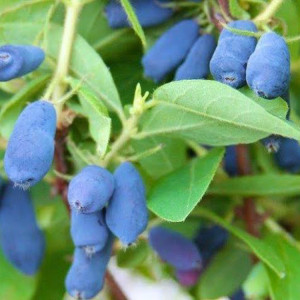 These compact, small pretty European bushes are our first fruits to ripen at the nursery. Very hardy, they thrive in Siberia. The flowers are not showy or scented like a honeysuckle vine but the fruits are good. Blue, tart and flavorful, the fruits ripen before strawberries. Can be shy producers in areas prone to late frosts. Also known as Honeyberry, Tundra edible honeysuckle is a easy care addition to any landscape. They perform best in colder zones 5,4,and 3.Tundra's fruits are large compared to other cultivars with the average fruit weighing 1.5 grams. The plump fruits are highly aromatic, black raspberry sweetness with a blueberry tang. Tundra has top rated flavor among all named varieties. The fruits shape, light blue color, and size are very attractive. Tundra needs Berry Blue to set fruit. Bush height 4-5' Zone 3-7. Space 4' circle.
These compact, small pretty European bushes are our first fruits to ripen at the nursery. Very hardy, they thrive in Siberia. The flowers are not showy or scented like a honeysuckle vine but the fruits are good. Blue, tart and flavorful, the fruits ripen before strawberries. Can be shy producers in areas prone to late frosts. Also known as Honeyberry, Tundra edible honeysuckle is a easy care addition to any landscape. They perform best in colder zones 5,4,and 3.Tundra's fruits are large compared to other cultivars with the average fruit weighing 1.5 grams. The plump fruits are highly aromatic, black raspberry sweetness with a blueberry tang. Tundra has top rated flavor among all named varieties. The fruits shape, light blue color, and size are very attractive. Tundra needs Berry Blue to set fruit. Bush height 4-5' Zone 3-7. Space 4' circle.
View detailed information
|
| Maxie Edible Haskap Honeysuckle Bush - Lonicera caerulea ssp. emphyllocalyx |
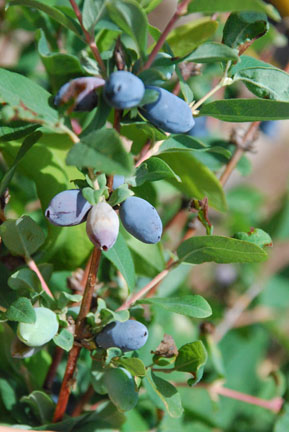 The new Maxie edible honeysuckle bush is more adapted to moderate climates such as Virginia. We've grown edible honeysuckle bush varieties since 1989 with meager harvests. Maxie and Solo may prove to be more productive. The berries should be sweeter than other popular varieties with an 18 brix reading.(Measurement for sugars in fruit. 18 is minimal number for California grapes to be dried to raisins.) Maxie and Solo are bred by Maxine Thompson. She used a Japanese sub species in her breeding work resulting in a more adaptable sweeter plant and fruit. The Japanese term for these plants is Haskap. The bushes are pretty, compact with an extended blooming period. The flowers bloom later than other popular varieties which is a plus for areas of fluctuating winter temperatures. Maxie needs to be pollinated by Solo. Space 3' circle Zones 3-8
The new Maxie edible honeysuckle bush is more adapted to moderate climates such as Virginia. We've grown edible honeysuckle bush varieties since 1989 with meager harvests. Maxie and Solo may prove to be more productive. The berries should be sweeter than other popular varieties with an 18 brix reading.(Measurement for sugars in fruit. 18 is minimal number for California grapes to be dried to raisins.) Maxie and Solo are bred by Maxine Thompson. She used a Japanese sub species in her breeding work resulting in a more adaptable sweeter plant and fruit. The Japanese term for these plants is Haskap. The bushes are pretty, compact with an extended blooming period. The flowers bloom later than other popular varieties which is a plus for areas of fluctuating winter temperatures. Maxie needs to be pollinated by Solo. Space 3' circle Zones 3-8
View detailed information
|
| Solo Edible Haskap Honeysuckle Bush - Lonicera caerulea ssp. emphyllocalyx |
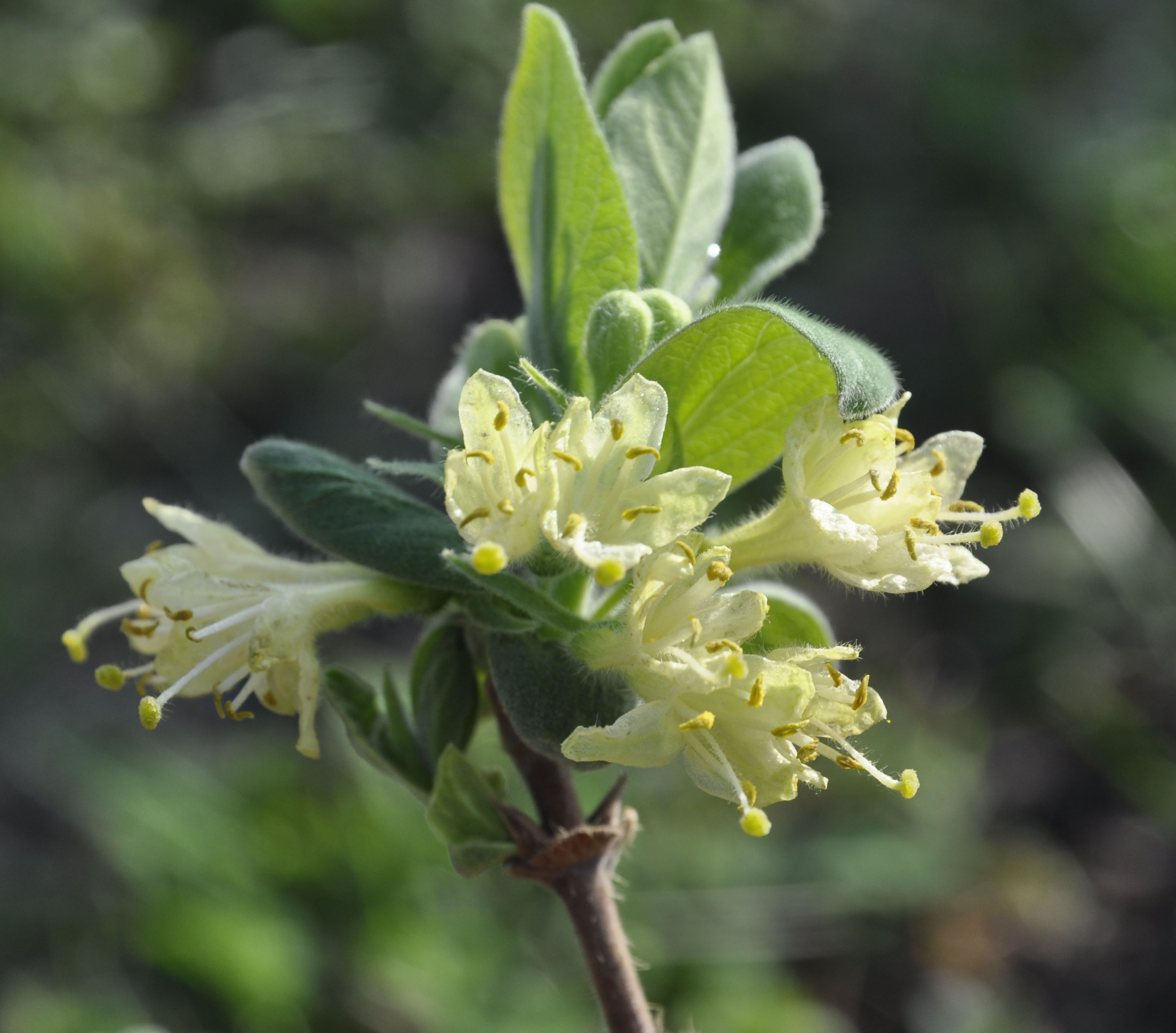 The new Solo edible honeysuckle bush is more adapted to moderate climates such as Virginia. We've grown edible honeysuckle bush varieties since 1989 with meager harvests. Maxie and Solo may prove to be more productive. The berries should be sweeter than other popular varieties with an 18 brix reading.(Measurement for sugars in fruit. 18 is minimal number for California grapes to be dried to raisins.) Maxie and Solo are bred by Maxine Thompson. She used a Japanese sub species in her breeding work resulting in a more adaptable sweeter plant and fruit. The Japanese term for these plants is Haskap. The bushes are pretty, compact with an extended blooming period. The flowers bloom later than other popular varieties which is a plus for areas of fluctuating winter temperatures. Maxie needs to be pollinated by Solo. Solo is self fertile, but the fruits are twice the size if pollinated. Space 3' circle Zones 3-8
The new Solo edible honeysuckle bush is more adapted to moderate climates such as Virginia. We've grown edible honeysuckle bush varieties since 1989 with meager harvests. Maxie and Solo may prove to be more productive. The berries should be sweeter than other popular varieties with an 18 brix reading.(Measurement for sugars in fruit. 18 is minimal number for California grapes to be dried to raisins.) Maxie and Solo are bred by Maxine Thompson. She used a Japanese sub species in her breeding work resulting in a more adaptable sweeter plant and fruit. The Japanese term for these plants is Haskap. The bushes are pretty, compact with an extended blooming period. The flowers bloom later than other popular varieties which is a plus for areas of fluctuating winter temperatures. Maxie needs to be pollinated by Solo. Solo is self fertile, but the fruits are twice the size if pollinated. Space 3' circle Zones 3-8
View detailed information Sorry, we are currently out of this item, please check back!
|
| Edible Haskap Honeysuckle - Lonicera kamtschatica |
 These Haskap Honeysuckles lost their tags. They could be any of the following varieties - Indigo Gem, Indigo Treat, or Tundra. They need to be paired with Berry Blue Haskap for pollination. These compact, small pretty European bushes are our first fruits to ripen at the nursery. Very hardy, they thrive in Siberia. The flowers are not showy or scented like a honeysuckle vine but the fruits are good. Blue, tart and flavorful, the fruits ripen before strawberries. Can be shy producers in areas prone to late frosts. Also known as Honeyberry. Zone 3-7. Space 4' circle
These Haskap Honeysuckles lost their tags. They could be any of the following varieties - Indigo Gem, Indigo Treat, or Tundra. They need to be paired with Berry Blue Haskap for pollination. These compact, small pretty European bushes are our first fruits to ripen at the nursery. Very hardy, they thrive in Siberia. The flowers are not showy or scented like a honeysuckle vine but the fruits are good. Blue, tart and flavorful, the fruits ripen before strawberries. Can be shy producers in areas prone to late frosts. Also known as Honeyberry. Zone 3-7. Space 4' circle
View detailed information
|
| Regent Juneberry - Amelanchier alnifolia |
|---|
 Regent is a hardy juneberry bush from South Dakota. The very productive bush has sweet blueberry like fruits up to 1/2" in diameter. The good red fall color, profuse white spring flowers, followed by bunches of fruit make this trouble-free plant an all season ornamental. The plant only reaches 4'-6' tall with the same spread. Great for easy picking. The fruits ripen the first week of June. Many of our clients just stand around the bush and enjoy. Plant a row of this native plant for effect or serious picking. Also called saskatoon and serviceberry in different parts of the country. Zones 4-8.
Regent is a hardy juneberry bush from South Dakota. The very productive bush has sweet blueberry like fruits up to 1/2" in diameter. The good red fall color, profuse white spring flowers, followed by bunches of fruit make this trouble-free plant an all season ornamental. The plant only reaches 4'-6' tall with the same spread. Great for easy picking. The fruits ripen the first week of June. Many of our clients just stand around the bush and enjoy. Plant a row of this native plant for effect or serious picking. Also called saskatoon and serviceberry in different parts of the country. Zones 4-8.
View detailed information Sorry, we are currently out of this item, please check back!
|
| Autumn Brilliance Juneberry - Amelanchier grandifolia |
 Autumn Brilliance Juneberry is an easy to grow native that adapts to a wide range of soils and climatic zones. Fruits are good size about one half inch in diameter and sweet and pleasant picked fresh. Also called serviceberry, Autumn Brilliance blooms a mass of clustered white flowers very early in spring and bears clusters of blueberry like fruits in June. Then, in the fall, the small tree turns vivid red. There is usually more than enough fruit for putting up for later use. Zones 3-8 Space 15' circle
Autumn Brilliance Juneberry is an easy to grow native that adapts to a wide range of soils and climatic zones. Fruits are good size about one half inch in diameter and sweet and pleasant picked fresh. Also called serviceberry, Autumn Brilliance blooms a mass of clustered white flowers very early in spring and bears clusters of blueberry like fruits in June. Then, in the fall, the small tree turns vivid red. There is usually more than enough fruit for putting up for later use. Zones 3-8 Space 15' circle
View detailed information
|
| Phil's Sweet Pomegranate - Prunica granatum |
|---|
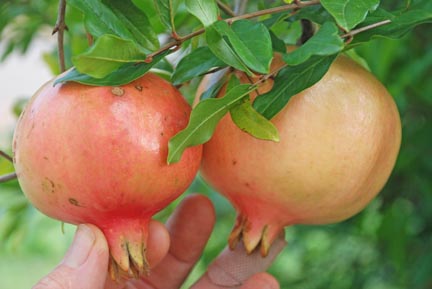 This variety is much sweeter than the store bought "Wonderful" variety. Medium to large fruit, skin slightly pink; seeds have a high sugar content with slight acid overtones. Seeds are soft and hardly noticeable. Shrub is productive but has suffered winter damage at the nursery. Soft seeded varieties are not as hardy as hard seeded varieties. Fruits are ripe towards the end of September here. Flowers are orange-red with a long bloom period.. Space 8'-10' circle. Hardy to 6 degrees F. when planted in a protected spot. Plant out of the wind in zone 7, perhaps near a building on the south or east side. Self fertile. Zones 7-10
This variety is much sweeter than the store bought "Wonderful" variety. Medium to large fruit, skin slightly pink; seeds have a high sugar content with slight acid overtones. Seeds are soft and hardly noticeable. Shrub is productive but has suffered winter damage at the nursery. Soft seeded varieties are not as hardy as hard seeded varieties. Fruits are ripe towards the end of September here. Flowers are orange-red with a long bloom period.. Space 8'-10' circle. Hardy to 6 degrees F. when planted in a protected spot. Plant out of the wind in zone 7, perhaps near a building on the south or east side. Self fertile. Zones 7-10
View detailed information Please contact our office to see about availability. 434.361.9134
|
| Russian Pomegranate Salavatski - Punica granatum |
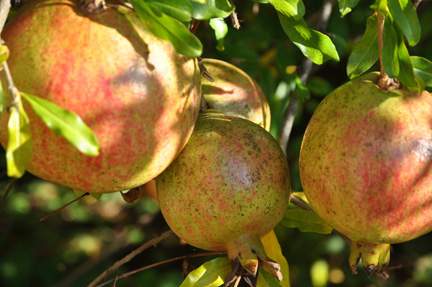 Dr. Chris Inhulsen, Montezuma, Ga., tested Russian pomegranates and found they survived winters where the popular "Wonderful" variety killed to the ground. The plants were reported to take -6 degrees F once, and at Montezuma, GA., 8 degrees F. Salavatski was his first choice for hardy, dependable, high quality fruit. The fruits as large as the store-bought "Wonderful" variety, and are orange-red in skin and red arils. Like "Wonderful" it is a hard seeded variety. According to Dr. Levin, the originator of the variety, the hard seeded varieties can withstand colder temperatures by a few degrees than the soft seeded varieties. We can thank Dr. Levin for the many pomegranate varieties.He has given us a new fruit for our area that is beautiful and easy to grow. At our nursery in Virginia, Salavatski has fruited yearly without winter damage to the plant. Space 8' to 10' circle. It's best to plant out of the winter winds. More protection and less in the open helps especially with younger plants. Self fertile, Salavatski has ripened in Lancaster, PA(Zone 6) planted on the south side of a home. Zones 7-10.
Dr. Chris Inhulsen, Montezuma, Ga., tested Russian pomegranates and found they survived winters where the popular "Wonderful" variety killed to the ground. The plants were reported to take -6 degrees F once, and at Montezuma, GA., 8 degrees F. Salavatski was his first choice for hardy, dependable, high quality fruit. The fruits as large as the store-bought "Wonderful" variety, and are orange-red in skin and red arils. Like "Wonderful" it is a hard seeded variety. According to Dr. Levin, the originator of the variety, the hard seeded varieties can withstand colder temperatures by a few degrees than the soft seeded varieties. We can thank Dr. Levin for the many pomegranate varieties.He has given us a new fruit for our area that is beautiful and easy to grow. At our nursery in Virginia, Salavatski has fruited yearly without winter damage to the plant. Space 8' to 10' circle. It's best to plant out of the winter winds. More protection and less in the open helps especially with younger plants. Self fertile, Salavatski has ripened in Lancaster, PA(Zone 6) planted on the south side of a home. Zones 7-10.
View detailed information
|
| Crimson Sky Pomegranate - Punica granatum |
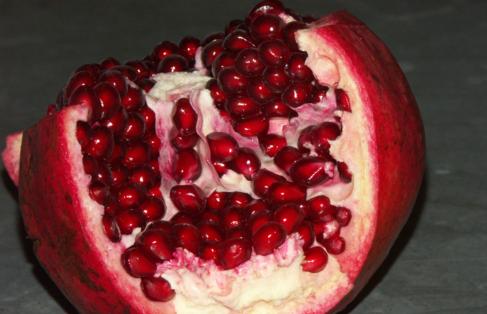 Nikitskii Ranii Pomegranate is called Crimson Sky in the US. Also called R19 when planted at the original University of Georgia test plot of Dr. Levin's hardiest varieties from Turkmanistan. Ranii in Russian means early. Crimson Sky ripens its fruits early in October. They are consistently bright red with a very appealing taste, sweet and tart. Very hardy like Salavatski. Self fertile. Space 10' circle Zone 7-8 For trial in zone 6
Nikitskii Ranii Pomegranate is called Crimson Sky in the US. Also called R19 when planted at the original University of Georgia test plot of Dr. Levin's hardiest varieties from Turkmanistan. Ranii in Russian means early. Crimson Sky ripens its fruits early in October. They are consistently bright red with a very appealing taste, sweet and tart. Very hardy like Salavatski. Self fertile. Space 10' circle Zone 7-8 For trial in zone 6
View detailed information
|
| Parfianka Russian Pomegranate - Punica granatum |
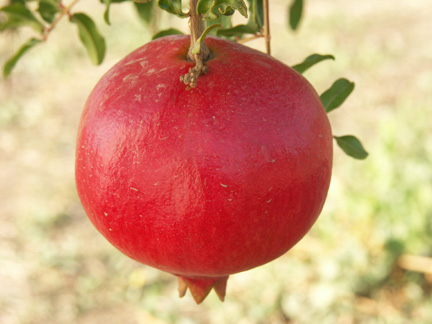 Originally imported from Dr. Gregory Levin at the Garrigala agricultural station in Turkmenistan. Parfianka is a favored selection from a collection of over 1000 Pomegranate varieties. The fruit is quite large and highly colored in beautiful bright red. The arils are large and bright red with a very small, soft, edible seed. The fruit is of the highest quality.100 to 200 chill hours. Self fruitful. Space 10' circle. Zone 7B - 9.
Originally imported from Dr. Gregory Levin at the Garrigala agricultural station in Turkmenistan. Parfianka is a favored selection from a collection of over 1000 Pomegranate varieties. The fruit is quite large and highly colored in beautiful bright red. The arils are large and bright red with a very small, soft, edible seed. The fruit is of the highest quality.100 to 200 chill hours. Self fruitful. Space 10' circle. Zone 7B - 9.View detailed information
|
| Makedonia Red Pomegranate - Punica granatum |
|
Hardy pomegranate from Southern Europe near Greece. First grown in the US in Bethlehem, PA. Makedonia was sent to us several years ago. It has proven winter hardy here for the last several winters. Plant is bushy and compact. Zones 6-9 Space 6' circle
View detailed information
|
| Bala Mursal Russian Pomegranate - Punica |
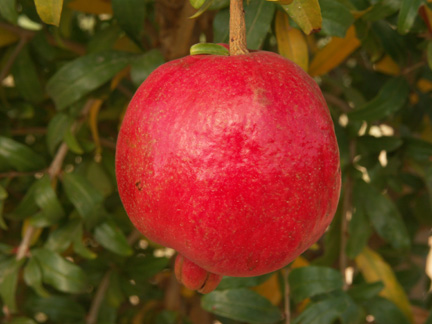 Bala Mursal is considered one of the best varieties for juicing, having 70 percent juice and 12 to 20 percent sugars. Skin color of fruit is deep red as is the juice. Fruits can keep for 3-4 months. Can produce up to 90 lbs. of fruit per bush. Commercially grown in Azerbaijan. It has succeeded in Georgia since the 70's. Also called Cranberry and R25 in the US. In Georgia trials along with Nikitski Ranni, had the highest fruit yield and post harvest attributes than all others tested. Reported as hardy as Salavatski. According to Michael Hothchkiss, past curator at the Georgia experimental planting, Bala is medium to large fruit, speckled pink/red rind. Seeds "pop" when you chew them. Good fresh eating with jam like flavor, but probably best for juice due to harder seed. Self fertile. Height up to 10 feet. Zones 7-9 Space 10' circles.
Bala Mursal is considered one of the best varieties for juicing, having 70 percent juice and 12 to 20 percent sugars. Skin color of fruit is deep red as is the juice. Fruits can keep for 3-4 months. Can produce up to 90 lbs. of fruit per bush. Commercially grown in Azerbaijan. It has succeeded in Georgia since the 70's. Also called Cranberry and R25 in the US. In Georgia trials along with Nikitski Ranni, had the highest fruit yield and post harvest attributes than all others tested. Reported as hardy as Salavatski. According to Michael Hothchkiss, past curator at the Georgia experimental planting, Bala is medium to large fruit, speckled pink/red rind. Seeds "pop" when you chew them. Good fresh eating with jam like flavor, but probably best for juice due to harder seed. Self fertile. Height up to 10 feet. Zones 7-9 Space 10' circles.
View detailed information
|
| R-35 Surh-anor Russian Pomegranate - Punica |
 Surh Anor is hardy and resists late winter cold and slow to break bud. Resistant to high humidity problems on the fruit. Vigorous bush, has preformed as well as Salavatski in Alma, Georgia. Part of the original test plot of Dr. Levin's best selections {R-35) from Turkmanistan at the USDA Byron Plant Station.A pink variety, very high quality large fruit. Consistently productive with clear to red speckled arils with a high sugar content. Zone 7-9 Space 12' circle
Surh Anor is hardy and resists late winter cold and slow to break bud. Resistant to high humidity problems on the fruit. Vigorous bush, has preformed as well as Salavatski in Alma, Georgia. Part of the original test plot of Dr. Levin's best selections {R-35) from Turkmanistan at the USDA Byron Plant Station.A pink variety, very high quality large fruit. Consistently productive with clear to red speckled arils with a high sugar content. Zone 7-9 Space 12' circle
View detailed information Please contact our office to see about availability. 434.361.9134
|
| Favorite Lyubimy Pomegranate - Punica granatum |
 Favorite is the Russian pomegranate variety Lyubimy which translates to Favorite. A promising selection even in protected areas of Zone 6. Medium size tree, space 8-10' circle. Self fertile. Zone 7-9
Favorite is the Russian pomegranate variety Lyubimy which translates to Favorite. A promising selection even in protected areas of Zone 6. Medium size tree, space 8-10' circle. Self fertile. Zone 7-9
View detailed information
|
Due to import restrictions we are unable to ship Quince to CA...
| Toyo Nishiki Flowering Quince - Cydonia oblonga |
|---|
 Toyo Nishiki Flowering Quince is a compact, ornamental shrub that's much more disease resistant than "fruiting quince". It thrives in the landscape. With large pinkish white blooms turning to larger than average fruits used for jellies and jams, especially mixed jams because the fruits contain a lot of pectin. The flowers bloom early with forsythia. Toyo-Nashiki is noted for bearing flowers of different colors (pinks, reds and whites) on the same branches. Interesting color variations also may occur on the same flower. Fruits mature in fall. Space 6' circle. Plants are 4-6' tall with about the same width. Zones 5-8
Toyo Nishiki Flowering Quince is a compact, ornamental shrub that's much more disease resistant than "fruiting quince". It thrives in the landscape. With large pinkish white blooms turning to larger than average fruits used for jellies and jams, especially mixed jams because the fruits contain a lot of pectin. The flowers bloom early with forsythia. Toyo-Nashiki is noted for bearing flowers of different colors (pinks, reds and whites) on the same branches. Interesting color variations also may occur on the same flower. Fruits mature in fall. Space 6' circle. Plants are 4-6' tall with about the same width. Zones 5-8
View detailed information Sorry, we are currently out of this item, please check back!
|
